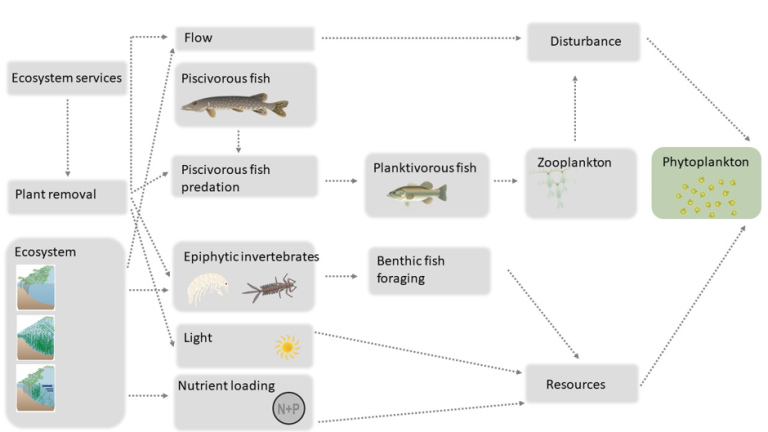MadMacs results
Key messages
We studied six sites in rivers and lakes with mass development of macrophytes (= aquatic plants). The sites were located in Norway, Germany, France, South Africa and Brazil, and the macrophytes were perceived as problematic by water managers and residents.
At each site, we – in collaboration with local water managers - mechanically removed the macrophytes from areas ranging from 550 m2 (Lake Grand Lieu) to 70,000 m2 (River Spree), reflecting current management practices. We quantified the short-term consequences (up to six weeks) of macrophyte removal on biogeochemistry and biodiversity, comparing each site from which the macrophytes were removed with a nearby site in which the macrophytes were left standing.
We distributed questionnaires, in which we asked residents and tourists how they perceive the aquatic vegetation. We also quantified ecosystem services and compared the current situation with scenarios where the macrophytes were fully removed, as well as with a “do-nothing” scenario, i.e. where the macrophytes were left standing.
Overall, we learned the following lessons:
- Mass developments of macrophytes often occur in ecosystems which (unintentionally) were turned into a «perfect habitat» for aquatic plants
- Reduced ecosystem disturbance can cause macrophyte mass developments even if nutrient concentrations are low
- Macrophyte removal treats the symptom rather than the cause
- Removal of non-native macrophytes may lead to nuisance growth of other macrophytes
- The effect of macrophyte removal on ecosystem carbon emissions is site-specific
- The consequences of partial macrophyte removal on the biodiversity of other aquatic organism groups are variable but generally small
- Dense stands of macrophytes raise the water level of streams and adjacent groundwater
- Nobody likes macrophyte mass developments, but visitors tend to regard them as less of a nuisance than residents
- Aquatic plant management often does not affect overall societal value of the ecosystem much
Guidelines for managing mass developments of macrophytes: a cookbook tool
Management of water courses with dense aquatic vegetation is challenging. MadMacs developed guidelines to assist managers of invaded waterbodies with decision-making on control options to rehabilitate aquatic ecosystems, thereby increasing biodiversity and improving the ecosystem structure and functioning of these crucial systems.
These guidelines outline appropriate methods to manage mass developments of macrophytes, while maximising ecosystem services based on the latest research of our multinational study.
Bayesian modelling tool to assess the risk of mass development and the consequences of macrophyte removal
What happens if we remove macrophytes?
The first task in developing a Bayesian Network (BN) model is to produce a causal flow chart (without feedback loops), e.g. as shown in Figure 1 below. Such flow chart can be co-constructed from the scientific literature, available data and knowledge from stakeholders. The nature and amount of knowledge to link the boxes (nodes) and provide probabilities of effects may be variable, from mathematical equations, data mining (descriptive statistics), expert or local knowledge. It is important to be transparent so that the user can appreciate the assumptions made and check out the source of information used.

MadMacs derived probabilities from general knowledge in ecology (food-web and alternative stable state: macrophyte clear water to phytoplankton green pea soup) and a global review of the effect of plant removal on ecosystem structure and function (Thiemer et al. 2021). The BN remains largely hypothetical and should only be used for illustrative purposes. The BN provides a mathematical platform to determine the probabilities of phytoplankton blooms as a function of a set of interrelated causes. Scientists and water managers can manipulate the BN to quantify this risk under different scenarios, e.g. to simulate alternative desirable ecosystem services.
Scientists and water managers may also set the risk of phytoplankton blooms (endpoint) to a specific target and see how probabilities are affected backwards throughout the whole BN, identifying key nodes on which the set target depends.
BNs provide an educational tool informing the discussion between scientists, managers and users of aquatic ecosystems: everyone learns everyone teaches.
Do you want to play?
The BN works with the software Netica, a free version is available here. The free version allows you to use (but not modify) the BN. Once you have installed Netica, download the MadMacs netica file. You should be able to see the BN as here.
For more information see Thiemer et al. (2021) and supplementary information therein.